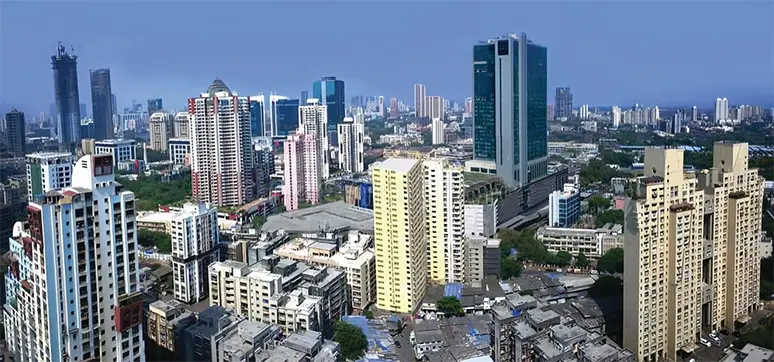Mumbai, being the financial capital and a model for development, is set to witness a transformation in its skyline, thanks to the recently approved revised elevation policy by the BMC commissioner. This policy, aimed at enhancing the aesthetics of buildings, brings back decorative exterior elements like chhajjas, cornices, crowns and pergolas, which had disappeared from architectural plans after the implementation of stringent policies in 2012.
THE HISTORY & THE RESULTS, A PART OF AN ACTION PLAN

Modifications have been permitted exclusively in accordance with the provisions outlined in the Development Control and Promotion Regulations of 2034. Among the approved alterations, pergolas can now be incorporated at the highest terrace level, projecting up to a maximum of two meters. Free-standing columns are now sanctioned for enhancing the architectural appeal of the building starting from the first floor, provided they are distinct from structural columns supporting the building and do not encroach upon open space, light, and ventilation.

This policy adjustment comes after at least three representations by the practising engineers, architects and the Town Planners Association (PEATA), a leading organisation representing architects and urban planners. PEATA advocated for modifying regulations that were perceived as restricting the architectural aspects of buildings, hindering architects and project proponents from creating iconic structures with aesthetically pleasing features.
The association highlighted that before the fungible FSI era in 2012; such elevation features were permissible, resulting in the construction of exceptional buildings. However, misuse of these features prompted the government to impose restrictions, as outlined in letters seeking modifications.
In 2012, BMC approvals were made more stringent to curb the misuse of elements such as large flower beds, lily ponds, and car decks by developers. Developers had exploited these elements, obtained free of FSI, to exceed the permitted built-up area, leading to windfall profits with terms like super built-up area.
PROS OF THE REVISED ELEVATION POLICY

Aesthetically Pleasing Skyline:
- The policy encourages the reintroduction of decorative elements, contributing to a more visually appealing cityscape.
- Architects now have the freedom to incorporate features like pergolas, free-standing columns, and planters, enhancing the overall architectural aesthetics.
Architectural Innovation:
- The modifications allow architects to explore new design possibilities, fostering innovation in building aesthetics.
- Free-standing columns, pergolas, & other features can be utilised to create iconic and unique buildings that redefine Mumbai’s urban identity.
Responsible Creativity:
- The policy shift emphasises responsible creativity, striking a balance between regulatory prudence and architectural innovation.
- This move is seen as a game-changer by industry experts, promoting a transformative era in Mumbai’s urban development.
Development Control and Promotion Regulations 2034 Compliance:
- The revisions are aligned with the provisions of the Development Control and Promotion Regulations 2034, ensuring that the changes are within the framework of urban planning guidelines.
CONS OF THE REVISED ELEVATION POLICY

Historical Misuse of Features:
- The stringent policies implemented in 2012 were a response to the misuse of decorative features, such as large flower beds and lily ponds, leading to developers exceeding permitted built-up areas for windfall profits.
- Scepticism arises regarding the potential for similar misuse under the revised policy.
Potential Impact on Open Spaces:
- While the policy allows for the inclusion of various features, there is a need for strict adherence to regulations preventing obstruction of open spaces, light, and ventilation.
- Improper implementation could lead to overcrowded and aesthetically cluttered spaces.
THE RESPONSE

Responding to the revised policy, the past president of PEATA, expressed excitement, calling it a game-changer for Mumbai’s skyline. He emphasised that the BMC’s policy shift opens the door for aesthetically pleasing buildings to grace the city, marking a transformative era where responsible creativity will redefine Mumbai’s urban identity, showcasing the city’s commitment to both regulatory prudence and architectural innovation.
THE OPPORTUNITIES FOR FAÇADE SYSTEMS IN ELEVATION DESIGNS

Mumbai’s architectural landscape is on the brink of a transformative era with the recent approval of the revised elevation policy. This policy not only brings back decorative exterior elements but also opens up new opportunities for façade specialists and façade systems to play a pivotal role in reshaping the city’s skyline.
- Reintroduction of Decorative Elements: The revised policy, which allows the return of elements like chhajjas, cornices, crowns, and pergolas, presents a golden opportunity for façade specialists to showcase their expertise. These professionals can contribute to the revival of these aesthetic features while ensuring their integration with modern building technologies.
- Incorporating Façade Systems for Aesthetic Enhancements: Façade specialists can leverage advanced systems to seamlessly integrate decorative features into the building’s exterior. The use of innovative materials and technologies can enhance both the visual appeal and functionality of these elements.
-

Innovation in sustainable façades Compliance with Development Control and Promotion Regulations 2034: Façade specialists will play a crucial role in ensuring that the design and implementation of decorative elements comply with the provisions of the Development Control and Promotion Regulations 2034. Their expertise will be essential in navigating the regulatory framework while delivering aesthetically pleasing façades.
- Customisation and Iconic Designs: The new policy encourages architects and façade specialists to collaborate on creating iconic designs. Façade systems can be customised to complement the architectural vision, offering a unique identity to each building. This level of customisation can lead to the development of landmarks that redefine Mumbai’s urban identity.
- Innovation in Sustainable Façades: Façade specialists have an opportunity to not only focus on aesthetics but also to contribute to sustainable building practices. The integration of energy-efficient façade systems, green walls, and environmentally friendly materials aligns with global trends in sustainable architecture.
- Addressing Concerns and Mitigating Risks: Façade specialists can work proactively to address concerns related to potential misuse and overcrowding. By implementing design solutions that prioritise open spaces, light, and ventilation, these professionals can ensure that the aesthetic enhancements align with responsible urban development.
-

Addressing concerns and mitigating risks Collaboration with Architects & Urban Planners: Façade specialists can collaborate closely with architects and urban planners to bring their collective vision to life. This collaboration is crucial in maintaining a balance between architectural innovation and regulatory compliance.
Mumbai’s new elevation policies present a remarkable opportunity for façade specialists and façade systems to contribute significantly to the city’s evolving architectural narrative. By embracing innovation, customisation, and sustainable practices, these professionals can play a key role in reshaping the city’s skyline while adhering to regulatory guidelines.

The collaborative efforts of architects, urban planners, and façade specialists will be instrumental in ensuring that Mumbai’s buildings not only meet aesthetic standards but also contribute positively to the city’s overall urban development.














